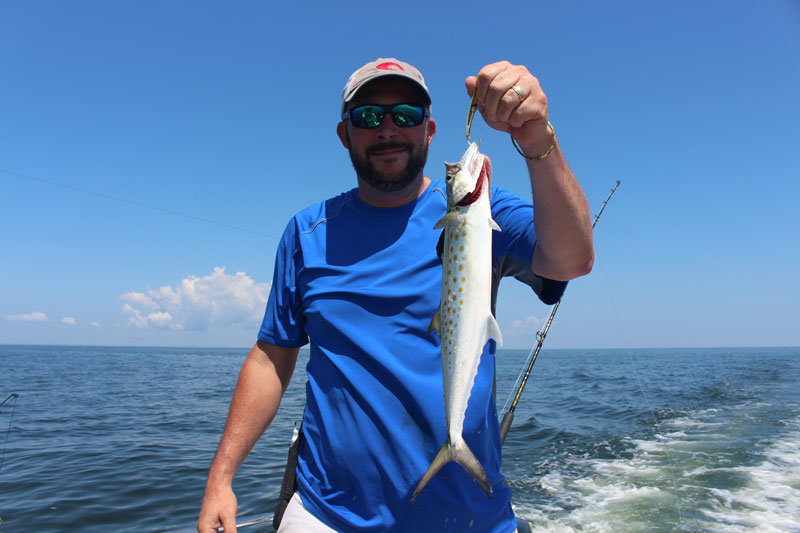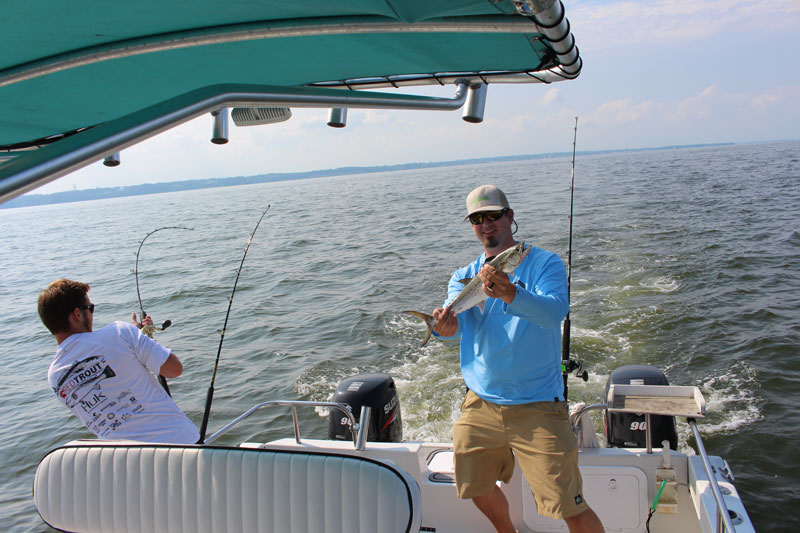Spanish mackerel and king mackerel are both present in the Mid-Atlantic region, but Spanish mackerel are far more prevalent and fishing for Spanish mackerel is popular among many anglers when Chesapeake Bay fishing during the summer months. It's also popular along coastal inshore waters most seasons. Before we look at this species in depth, check out this quick video about catching Spanish mackerel when they're mixed in with bluefish, using light tackle.
What are Spanish Mackerel?
Spanish Mackerel, or otherwise known as Scomberomorus maculatus, have two populations: one in the Gulf of Mexico, and one in the Atlantic Ocean. Spawning occurs along the Atlantic Coast from April to September and then the fish return to southern waters when the northern Atlantic coast begins to cool. Other common names for them are Atlantic Spanish mackerel, horse mackerel, spotted mackerel, Spaniard, and spotted cybium. Spanish Mackerel have sharp and pointed teeth with elongated bodies. They are covered in tiny scales and have small finlets running from the dorsal and anal fins to the forked tail fin. Spanish Mackerel have a greenish or bluish back with a silver belly and their silver sides have brassy oval spots. They can reproduce by age two and they travel in fast-moving schools. Spanish Mackerel can grow up to two feet in length and live five to eight years.

Spanish Mackerel travel in schools and catch their prey, usually Bay anchovies and small menhaden, by chasing the smaller bait to the surface and feeding off of them there. If you see birds diving for bait, there is a high probability that Spanish Mackerel are among the fish driving those baits to the surface.
Record Spanish Mackerel
Let's look at some state records: The largest Spanish Mackerel landed In Delaware was caught by Eric Ludwig in the year 2000, and weighed 6.4 pounds.
The record for the Maryland Chesapeake Bay is a 12.4 pound fish caught by Dean Mitchell in October 2007.
Virginia’s state record for Spanish Mackerel was caught back in 1993 by Everett Cameron and weighed 9 lbs. and 13 oz.
When and Where to Fish for Spanish Mackerel
Spanish mackerel are found in the Chesapeake Bay, off the Atlantic coast of the United States, and in the Gulf of Mexico, but it’s the Florida stocks that migrate north to the Chesapeake Bay. They usually arrive in late spring, entering the mouth of the Bay by May or June. They return to Florida in the fall, and often depart Bay waters abruptly after a few early fall cold fronts pass through and water temperatures begin dropping rapidly.

Since the season is relatively limited and these fish migrate with the seasonal temperature changes, Spanish mackerel are caught mostly at the mouth of the Bay early in the season, in the Lower Bay through the summer and into fall, and in the Middle Bay from mid-summer through early fall. Spanish Mackerel in Delaware can be found in the lower Delaware Bay and off the coast into the Atlantic Ocean, but are less common than in Maryland and Virginia waters and are usually present only during the mid-summer months.
How to Fish for Spanish Mackerel
The most popular way to catch Spanish Mackerel is by trolling. In our area, people either use number-one or number-two diving planers, trailed by a small gold or silver spoon 15 to 20 feet back on a 30 pound test leader. It's important to use a swivel behind the planer, to prevent line twist. Some anglers also pull a one- to three-ounce in-line sinker in front of a spoon. Spoon umbrella rigs can also be effective. Trolling speeds are usually between five and seven mph, but if bluefish and striped bass are present and you want to exclusively target the mackerel, speeding up another mph or two can reduce the bluefish catch.

There is another way to catch these speedsters, too: try casting to them. Casting small spoons and sinking plugs is effective when the fish can be spotted in a school, chasing bait on the surface. Fishing tip: when casting spoons or plugs, reel very quickly – Spanish mackerel like to chase fast-moving baits.
Spanish Mackerel Regulations
Now that you know the basics of how to catch Spanish mackerel in the Mid-Atlantic region, you’re going to need to know the regulations for the tristate area:
For more tips on fishing for Spanish mackerel in specific, also see How to Target Spanish Mackerel.
- By Maya Rogalski